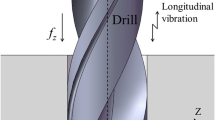Abstract
Difficult-to break chips in the process of drilling Ti-6Al-4V, especially in micro-hole machining of aviation parts, are always considered a main negative result. Although the advantage of longitudinal ultrasonic vibration–assisted drilling (L-UAD) in improving chip breaking is widely concerned, studies on chip shapes in longitudinal-torsional composite ultrasonic vibration–assisted drilling (LTC-UAD) are seldom reported. In this study, kinematic analysis of LTC-UAD was carried out, and the motion trajectory of tool cutting edge was constructed. On this basis, the cutting thickness model is established, and the dynamic change law of cutting thickness is analyzed. Furthermore, the conditions for complete geometric chip breaking are explored, and the matching criteria of process parameters for complete geometric chip breaking are derived. To verify the theoretical analysis, machining experiments are performed, wherein good agreement is found between the experimental and theoretical results. The results show that LTC-UAD has obvious advantages over conventional drilling (CD) in breaking chips. Additionally, the influences of the vibration amplitude, spindle speed, and feed rate on chip shapes are analyzed, revealing that a large amplitude and small feed rate are beneficial to chip breaking. The proper spindle speed can also greatly promote the chip-breaking effect.











Similar content being viewed by others
Data availability
All data used in the manuscript are available as submitted.
Code availability
Not applicable.
References
Chen G, Zou Y, Qin X, Liu J, Feng Q, Ren C (2020) Geometrical texture and surface integrity in helical milling and ultrasonic vibration helical milling of Ti-6Al-4V alloy. J Mater Process Technol 278:116494
Akula SP, Ojha M, Rao KL, Gupta AK (2023) A review on superplastic forming of Ti-6Al-4V and other titanium alloys. Mater Today Commun 105343
Lee WJ, Park SH, Yoon HS (2022) A coolant supply strategy based on cutting temperature prediction during the 3-axis end-milling of Ti-6Al-4V. J Manuf Process 84:272–281
Tong J, Zhang Z, Chen P, Zai P, Yang S, Bian P (2022) Study on surface morphology of titanium alloy curved thin-walled parts by longitudinal-torsional composite ultrasonic assisted milling. J Manuf Process 84:316–326
Xu J, El Mansori M (2016) Experimental study on drilling mechanisms and strategies of hybrid CFRP/Ti stacks. Compos Struct 157:461–482
Nath C, Kurfess T (2016) Obstruction-type chip breakers for controllable chips and improved cooling/lubrication during drilling–a feasibility study. Procedia Manufacturing 5:375–385
Wang FJ, Zhao M, Fu R, Yan JB, Qiu S, Hao JX (2021) Novel chip-breaking structure of step drill for drilling damage reduction on CFRP/Al stack. J Mater Process Technol 291:117033
Liu Q, Xu J, Yu H (2020) Experimental study of tool wear and its effects on cutting process of ultrasonic-assisted milling of Ti6Al4V. Int J Adv Manuf Technol 108:2917–2928
Jamshidi H, Nategh MJ (2013) Theoretical and experimental investigation of the frictional behavior of the tool–chip interface in ultrasonic-vibration assisted turning. Int J Mach Tools Manuf 65:1–7
Chen S, Zou P, Wu H, Kang D, Wang W (2019) Mechanism of chip formation in ultrasonic vibration drilling and experimental research. Proc Inst Mech Eng C J Mech Eng Sci 233(15):5214–5226
Tian Y, Zou P, Yang X, Kang D (2020) Study on chip morphology and surface roughness in ultrasonically assisted drilling of 304 stainless steel. Int J Advanced Manuf Technol 108(7):2079–2090
Lotfi M, Amini S (2017) Experimental and numerical study of ultrasonically-assisted drilling. Ultrasonics 75:185–193
Gao G, Yuan Z, Xia Z, Fu Z, Xiang D, Zhao B (2021) Study on thrust force of ultrasonic-assisted vibration micro-hole drilling of titanium alloy. Int J Adv Manuf Technol 112:3399–3413
Gao G, Xia Z, Yuan Z, Xiang D, Zhao B (2021) Influence of longitudinal-torsional ultrasonic-assisted vibration on micro-hole drilling ti-6al-4v. Chin J Aeronaut 34(9):247–260
Yarar E, Karabay S (2020) Investigation of the effects of ultrasonic assisted drilling on tool wear and optimization of drilling parameters. CIRP J Manuf Sci Technol 31:265–280
Zai P, Tong J, Liu Z, Zhang Z, Song C, Zhao B (2021) Analytical model of exit burr height and experimental investigation on ultrasonic-assisted high-speed drilling micro-holes. J Manuf Process 68:807–817
Rajaguru J, Arunachalam N (2021) Effect of ultrasonic vibration on the performance of deep hole drilling process. Procedia Manuf 53:260–267
Celaya A, Lopez de Lacalle LN, Campa FJ, Lamikiz A (2010) Ultrasonic assisted turning of mild steels. Int J Mater Prod Technol 37(1–2):60–70
Liu Y, Li Q, Qi Z, Chen W (2021) Defect suppression mechanism and experimental study on longitudinal torsional coupled rotary ultrasonic assisted drilling of CFRPs. J Manuf Process 70:177–192
Wang J, Feng P, Zhang J, Guo P (2018) Reducing cutting force in rotary ultrasonic drilling of ceramic matrix composites with longitudinal-torsional coupled vibration. Manuf Lett 18:1–5
Acknowledgements
The authors sincerely appreciate all the support.
Funding
This work was supported by the National Natural Science Foundation of China (U1804145).
Author information
Authors and Affiliations
Corresponding author
Ethics declarations
Ethical approval
Not applicable.
Consent to participate
Not applicable.
Consent for publication
Not applicable.
Competing interests
The authors declare no competing interests.
Additional information
Publisher's Note
Springer Nature remains neutral with regard to jurisdictional claims in published maps and institutional affiliations.
Rights and permissions
Springer Nature or its licensor (e.g. a society or other partner) holds exclusive rights to this article under a publishing agreement with the author(s) or other rightsholder(s); author self-archiving of the accepted manuscript version of this article is solely governed by the terms of such publishing agreement and applicable law.
About this article
Cite this article
Tian, Y., Zou, P., Wang, X. et al. Study on chip shapes in longitudinal-torsional composite ultrasonic vibration–assisted drilling of Ti-6Al-4V. Int J Adv Manuf Technol 128, 5561–5571 (2023). https://doi.org/10.1007/s00170-023-12242-y
Received:
Accepted:
Published:
Issue Date:
DOI: https://doi.org/10.1007/s00170-023-12242-y




